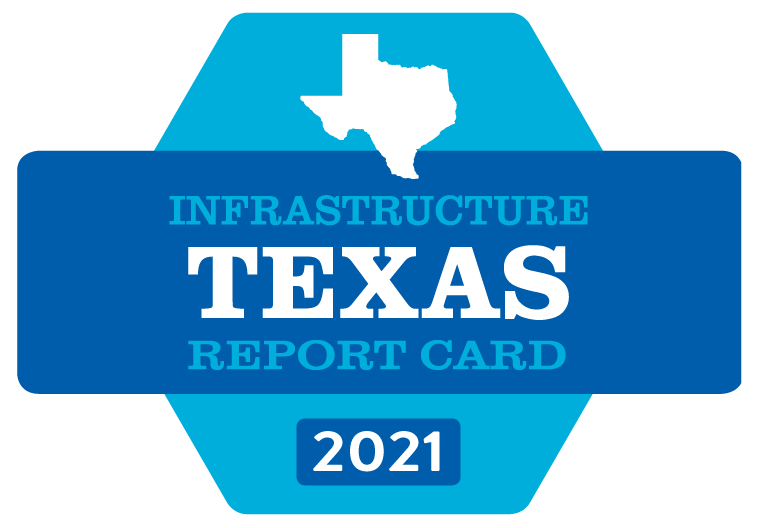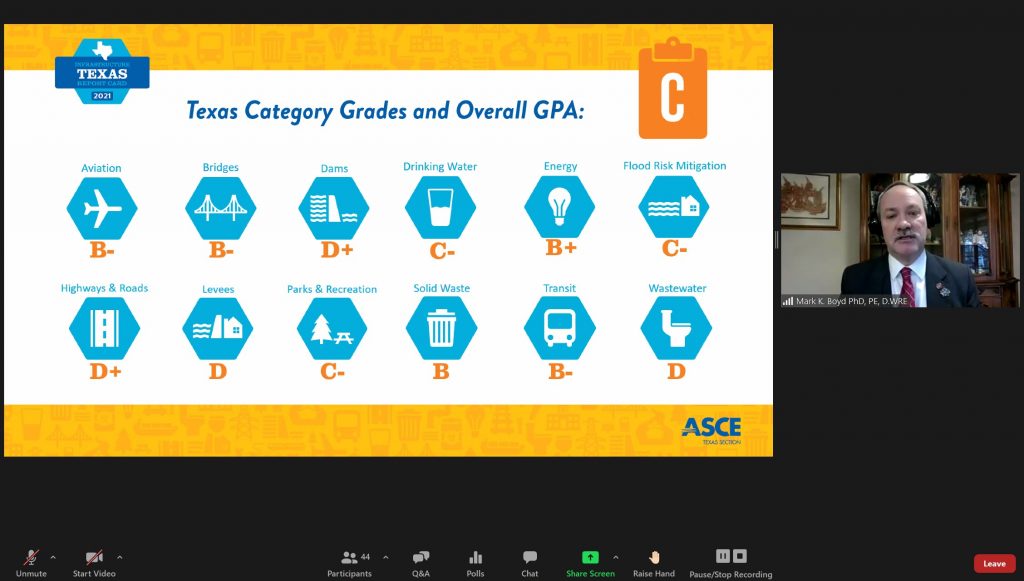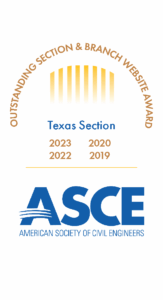Reliability and Resilience in the Balance
February 10, 2021
Grades across 12 categories range from a “B+” for energy to a “D” for levees and wastewater

The Texas Section of the American Society of Civil Engineers (ASCE) today released the 2021 Texas Infrastructure Report Card. Texas civil engineers gave 12 categories of infrastructure an overall grade of a ‘C,’ meaning the state’s infrastructure is in mediocre condition. This is an improvement from the ‘C-‘ the state received in its 2017 report.
As the 9th largest economy in the word, Texas infrastructure is crucial to the economy. Energy infrastructure systems have received significant attention, with Texas emerging as a leader in renewable energy production, meeting demands as the population continues to grow. Conversely, the wastewater and levee networks need additional support as the population grows and to withstand increased severe weather events. Civil engineers graded aviation (B-), bridges (B-), dams (D+), drinking water (C-), energy (B+), flood risk mitigation (C-), levees (D), public parks & recreation (C-), highways & roads (D+), solid waste (B), transit (B-) and wastewater (D).
“The ASCE Texas Infrastructure Report Card is a critical tool as we assess our needs and measure progress in actively building Texas into a better place to live, work, and raise a family,” said Representative Dennis Paul PE. “We must continue to work together with all levels of government, community leaders, industry partners, and universities, using this invaluable resource to help keep us better informed about the issues facing Texas.”
Energy infrastructure received the highest grade of a ‘B+,’ with advancements in oil and gas infrastructure helping maintain the state’s stellar reputation as a leading energy producer and provider. The equivalent of the ninth-largest economy in the world, Texas leads the U.S. in oil and gas energy production at more than a fifth of nationally produced energy. The state has experienced dramatic growth of oil production in recent years, from 1 million barrels per day in 2011 to over 5.4 million barrels per day in 2019. Texas is also the leading wind power generator in the nation.
There were several notable successes among the transportation sector as well. The Lone Star State has done well to accommodate significant population growth through meaningful attention to its aviation (B-), bridges (B-) and transit (B-) sectors. Texas is a critical aviation hub for the nation’s domestic and international passenger travel and air freight—boarding 90 million passengers and moving 5.8 million tons of cargo in 2019 alone. Providing 1.1 million jobs and contributing $41.8 billion to local payrolls, the aviation industry delivers an overall economic impact of $130 billion to the state’s economy. On the ground, Texas maintains the largest bridge inventory in the nation at nearly 57,000 bridge structures with an astounding 737 million vehicle crossings a day. Despite significant usage, Texas’ network boasts the smallest percentage (1.3%) of structurally deficient bridges in the nation. In 2018, TxDOT classified 82% of bridges as “good” condition or better, and zero crashes occurred due to poor bridge conditions. Public transportation continues to experience significant innovations, including Austin Cap Metro’s recently approved $7 billion program known as Project Connect, which will add Light Rail and Bus Rapid Transit.

“In this Report Card, our Committee of strong civil engineers and leaders, has succeeded in describing the current condition of our infrastructure and predicted funding needs,” Mark K. Boyd PhD, PE, DWRE, M.ASCE, Chair, ASCE Texas Section Infrastructure Report Card Committee. “Throughout the process, we as civil engineers, reminded ourselves of the organization’s mission and how our efforts support it: To build a better quality of life across the street and around the world—leveraging smart infrastructure maintenance and design.”
Wastewater and levees received the lowest grades in the report, each earning a ‘D.’ Unlike the state’s drinking water infrastructure, Texas wastewater infrastructure is in steady decline, facing a funding shortfall of more than $200 million. The number of sanitary sewer overflows has more than doubled in the last 4 years, increasing from 2,500 to almost 6,000.
Levees and dams are each hindered by a lack of condition data and insufficient resources to ensure these structures are able to protect local communities and residents. More than 1 million Texans and $127 billion dollars’ worth of property are protected by systems of levees—manmade structures that provide hurricane, storm, and flood protection. Texas has yet to establish a state levee program to begin building a clearer picture of the 327 levee systems extending a combined 567 miles – more than 75% of Texas levee systems have not received a screened risk classification.
A noteworthy grade improvement, flood risk mitigation received a ‘C-,’ marking a grade jump from the steady improvement over the previous four report cards (‘D-‘ in 2004 and 2008 and ‘D’ in 2012 and 2017). Texas has had the most weather-related deaths in the U.S. over the last five years. Since Hurricane Harvey, the state legislature has secured resources for flood mitigation and preparing systems for the omnipresent threat of severe weather impacts.
The report also includes calls to action to raise the grades, such as:
- LEAD WITH VISION. Leaders from all levels public and private must come together to ensure investments are spent wisely and mechanisms in place for maintenance, rehabilitation, and inspections.
- EDUCATE THE PUBLIC. Promote public education and improve stakeholder involvement with all planned infrastructure projects.
- PREPARE FOR THE FUTURE. Utilizing material reuse, higher standards, and emerging technologies ensures Texas infrastructure is resilient and sustainable.
The Report Card was created as a public service to citizens and policymakers to inform them of the infrastructure needs in their state. Civil engineers used their expertise and school report card-style letter grades to condense complicated data into an easy-to-understand analysis of Texas’ infrastructure network. ASCE State and Regional Infrastructure Report Cards are modeled after the national Infrastructure Report Card, which gave America’s infrastructure an overall grade of ‘D+’ in 2017.
To view a summary of the report card and all 12 categories, visit www.infrastructurereportcard.org/texas.
For more information on the ASCE Texas Section, visit www.TexASCE.org and follow us on Twitter, @TEXASCEtweets.
Contacts: Jenni Peters (512) 910-2272 | jpeters@texasce.org or Kevin Longley (202) 701-8768 | klongley@asce.org



